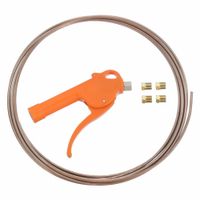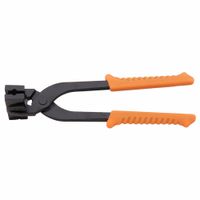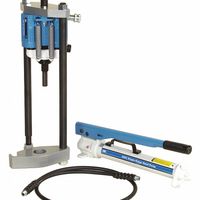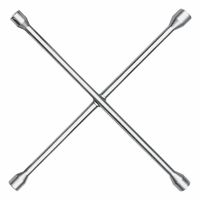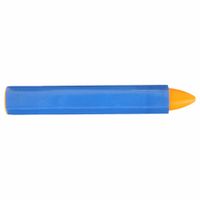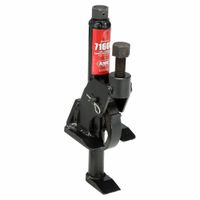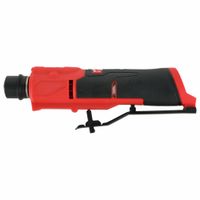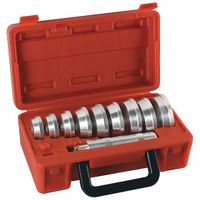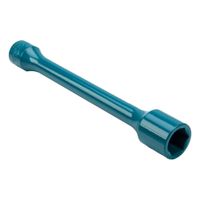Call +(254) 703 030 000 / 751 483 999 / 721 704 777
- Home
- Fleet Vehicle Maintenance
- Vehicle Tools
- Wheel Brake Tools
Wheel & Brake Tools
These tools repair, maintain, and replace tires and wheel assemblies. Lug nut wrenches are socket wrenches that tighten and loosen lug nuts on truck and automobile wheels. Wheel socket torque sticks and extensions connect to an impact wrench to loosen and tighten lug nuts. Tire repair tools patch ti .....Read More
Frequently Asked Questions
What are the essential tools for tire repair and maintenance?
Essential tools for tire repair and maintenance include:
1. **Tire Pressure Gauge**: Measures tire pressure to ensure it is at the recommended level, preventing uneven wear and improving fuel efficiency.
2. **Air Compressor**: Used to inflate tires to the correct pressure. Portable versions are available for on-the-go adjustments.
3. **Tire Repair Kit**: Contains patches, plugs, and adhesive for fixing punctures. Some kits include a rasp tool and insertion tool for plug repairs.
4. **Tire Iron or Lug Wrench**: Essential for loosening and tightening lug nuts when changing a tire.
5. **Jack**: A hydraulic or scissor jack is necessary for lifting the vehicle to remove or replace a tire.
6. **Tire Bead Breaker**: Used to separate the tire bead from the rim, facilitating tire removal.
7. **Valve Core Tool**: Removes and installs valve cores, allowing for tire deflation and inflation.
8. **Tire Balancer**: Ensures the tire is balanced on the wheel, preventing vibrations and uneven wear.
9. **Tire Changer**: A machine that assists in mounting and demounting tires from wheels, often used in professional settings.
10. **Torque Wrench**: Ensures lug nuts are tightened to the manufacturer's specifications, preventing over-tightening or under-tightening.
11. **Tire Tread Depth Gauge**: Measures tread depth to assess tire wear and determine if replacement is necessary.
12. **Wheel Alignment Tool**: Checks and adjusts the alignment of wheels to prevent uneven tire wear and improve handling.
13. **Rubber Mallet**: Helps in seating the tire bead on the rim without damaging the tire or wheel.
14. **Safety Equipment**: Includes gloves, safety glasses, and wheel chocks to ensure safety during tire maintenance.
These tools are crucial for maintaining tire health, ensuring safety, and extending the lifespan of tires.
How do lug nut wrenches work?
A lug nut wrench, also known as a tire iron or wheel brace, is a tool used to loosen and tighten lug nuts on vehicle wheels. It typically consists of a metal bar with a socket at one or both ends that fits over the lug nuts. The wrench works on the principle of leverage, allowing the user to apply greater force than they could with their bare hands.
When using a lug nut wrench, the socket end is placed over the lug nut. The user then applies force to the handle, turning it counterclockwise to loosen the nut or clockwise to tighten it. The length of the wrench provides leverage, making it easier to turn the nut. Some lug wrenches are cross-shaped, with four different socket sizes, providing versatility for different vehicles.
For stubborn or rusted lug nuts, a longer wrench or a breaker bar may be used to increase leverage. Some wrenches have a telescoping handle for adjustable length. Impact wrenches, powered by electricity or air, can also be used for quicker removal and installation.
Proper use of a lug nut wrench involves ensuring the socket fits snugly over the nut to prevent slipping and potential injury. It's important to follow a star or crisscross pattern when tightening lug nuts to ensure even pressure on the wheel. Over-tightening can damage the wheel or studs, while under-tightening can lead to wheel detachment.
In summary, a lug nut wrench is a simple yet effective tool that uses leverage to manipulate lug nuts, essential for wheel maintenance and tire changes.
What is the purpose of wheel socket torque sticks and extensions?
Wheel socket torque sticks and extensions are specialized tools used in automotive maintenance to ensure that lug nuts on vehicle wheels are tightened to the manufacturer's specified torque settings. The primary purpose of these tools is to prevent over-tightening or under-tightening of lug nuts, which can lead to wheel damage, brake rotor warping, or even wheel detachment while driving.
Torque sticks are designed to work with impact wrenches. They are essentially extensions that flex at a predetermined torque level, allowing the impact wrench to apply only the necessary amount of torque. This ensures that the lug nuts are tightened consistently and accurately without exceeding the specified torque. Each torque stick is color-coded and calibrated for a specific torque value, making it easy for technicians to select the correct one for the job.
Extensions, on the other hand, are used to reach lug nuts that are difficult to access due to wheel design or other obstructions. They provide the necessary length to connect the impact wrench to the lug nut, ensuring that the torque is applied evenly and effectively.
Using torque sticks and extensions helps maintain the integrity of the wheel assembly and enhances vehicle safety. They reduce the risk of human error in manual torque application and save time in professional automotive settings by streamlining the wheel installation process. Overall, these tools are essential for achieving precise and reliable torque application in wheel maintenance.
How do tire mounting and demounting tools function?
Tire mounting and demounting tools are essential for changing tires on vehicles, ensuring the process is efficient and safe. These tools function by providing the necessary leverage and support to remove and install tires onto wheel rims.
1. **Tire Iron/Lever**: This is a basic tool used to pry the tire bead over the rim edge. It functions by inserting the flat end between the tire and rim, allowing the user to apply force and lift the tire bead over the rim.
2. **Bead Breaker**: This tool is used to separate the tire bead from the rim. It functions by applying pressure to the sidewall of the tire, breaking the seal between the tire and rim. Manual bead breakers use leverage, while hydraulic or pneumatic versions use pressurized force.
3. **Tire Mounting Machine**: This is a more advanced tool that automates the mounting and demounting process. It functions by securing the wheel on a turntable, using a rotating arm to guide the tire bead over the rim. The machine often includes a bead breaker and an air inflation system.
4. **Tire Demounting Tool**: Specifically designed for removing tires, this tool functions by gripping the tire bead and pulling it over the rim edge. It often includes a handle for leverage and a hook or clamp to secure the bead.
5. **Air Compressor**: Used to inflate the tire once mounted, it functions by delivering pressurized air through a hose and valve, seating the tire bead against the rim and ensuring proper inflation.
These tools work together to facilitate the tire changing process, ensuring the tire is securely mounted or demounted without damaging the tire or rim.
What are tire marking tools used for?
Tire marking tools are used for various purposes related to the maintenance, identification, and management of tires. These tools are essential in automotive, racing, and tire manufacturing industries. Here are some of their primary uses:
1. **Identification and Tracking**: Tire marking tools help in identifying and tracking tires. This is crucial for inventory management, ensuring that each tire can be easily identified and matched with its corresponding vehicle or storage location.
2. **Quality Control**: In manufacturing, tire marking tools are used to mark tires that have passed quality control checks. This ensures that only tires meeting specific standards are distributed to the market.
3. **Tread Depth Indication**: Some tire marking tools are used to indicate tread depth. This helps in assessing the wear and tear of a tire, ensuring that it is replaced before it becomes unsafe.
4. **Racing and Motorsport**: In racing, tire marking tools are used to label tires with specific information such as the type of compound, the number of laps completed, or the position on the vehicle. This helps teams make informed decisions about tire changes and strategies.
5. **Maintenance Records**: Marking tools are used to record maintenance activities, such as rotations, repairs, or replacements. This helps in maintaining a detailed history of each tire's usage and condition.
6. **Customization and Branding**: Tire marking tools can also be used for branding purposes, allowing manufacturers to imprint logos or other identifying marks on the tire sidewalls.
7. **Safety and Compliance**: Marking tools ensure that tires comply with safety regulations by marking them with necessary information such as load ratings, speed ratings, and manufacturing dates.
Overall, tire marking tools are vital for ensuring the efficient management, safety, and performance of tires across various applications.
How do wheel service tools assist in replacing wheel bearings?
Wheel service tools are essential in the process of replacing wheel bearings, as they ensure precision, safety, and efficiency. These tools are specifically designed to handle the complexities involved in removing and installing wheel bearings, which are critical components in a vehicle's suspension system.
Firstly, wheel service tools like bearing pullers and presses are used to remove the old bearings without causing damage to the wheel hub or other components. Bearing pullers apply even pressure to extract the bearing from its housing, preventing any misalignment or damage that could occur with improper tools. This is crucial because any damage to the hub can lead to costly repairs or replacements.
Once the old bearing is removed, a bearing press is used to install the new bearing. This tool ensures that the new bearing is seated correctly and evenly, which is vital for the proper functioning of the wheel assembly. An improperly installed bearing can lead to uneven wear, noise, and even failure, which can compromise vehicle safety.
Additionally, some wheel service tools come with adapters and attachments that accommodate different sizes and types of bearings, making them versatile for various vehicles. This adaptability is important for mechanics who work on multiple vehicle models.
Torque wrenches are also part of the wheel service toolkit, ensuring that all bolts and nuts are tightened to the manufacturer's specifications. Proper torque is essential to prevent the wheel from coming loose or causing undue stress on the bearing.
In summary, wheel service tools facilitate the precise and safe replacement of wheel bearings, ensuring that the vehicle operates smoothly and safely. They minimize the risk of damage to the wheel assembly and ensure that the new bearings are installed correctly, thereby extending the lifespan of the vehicle's suspension system.
What are the best practices for using brake tools in vehicle maintenance?
1. **Proper Tool Selection**: Use the right tools specifically designed for brake maintenance, such as brake caliper tools, brake bleeder kits, and brake pad spreaders, to ensure precision and safety.
2. **Safety First**: Always wear appropriate personal protective equipment (PPE) like gloves and safety glasses. Ensure the vehicle is securely lifted and supported with jack stands before starting any brake work.
3. **Clean Work Area**: Keep the work area clean and organized. Use brake cleaner to remove dust and debris from brake components before starting work to prevent contamination.
4. **Follow Manufacturer Guidelines**: Adhere to the vehicle manufacturer’s specifications and guidelines for brake maintenance to ensure compatibility and performance.
5. **Inspect Components**: Before using any tools, inspect brake components for wear and damage. Replace any worn or damaged parts to maintain optimal braking performance.
6. **Use Torque Wrenches**: When tightening bolts and nuts, use a torque wrench to apply the correct amount of torque as specified by the manufacturer to avoid over-tightening or under-tightening.
7. **Bleeding Brakes**: Use a brake bleeder tool to remove air from the brake lines. Follow the correct sequence and ensure the brake fluid reservoir is topped up to prevent air from entering the system.
8. **Lubrication**: Apply appropriate brake grease to moving parts like caliper slides and contact points to ensure smooth operation and prevent noise.
9. **Regular Maintenance**: Regularly check and maintain brake tools to ensure they are in good working condition. Clean and store them properly after use to prolong their lifespan.
10. **Training and Knowledge**: Stay updated with the latest brake maintenance techniques and tools through training and resources to ensure effective and safe practices.
